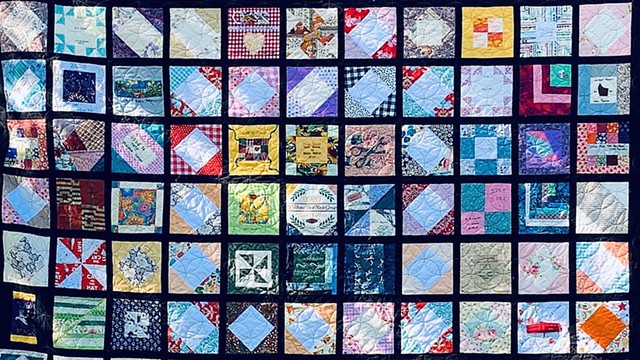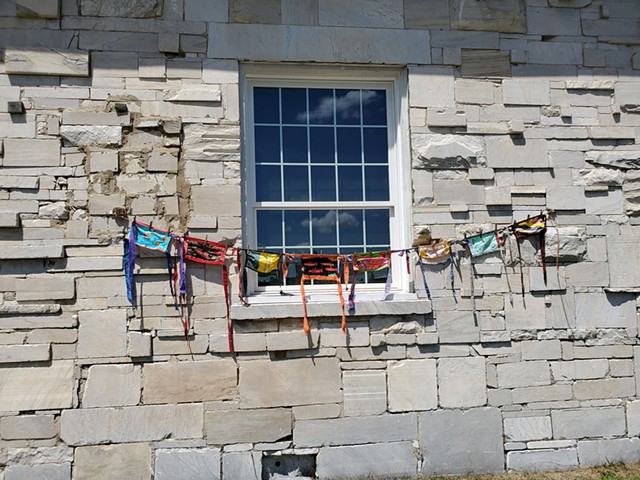
- Courtesy Of Pam Cross
- The St. Albans Face Mask Group's "Quilt of Hope"
On April 3, the Centers for Disease Control and Prevention officially recommended that Americans wear face masks to prevent the spread of the coronavirus. Sewists — a relatively new term for people who sew — were way ahead of them. By the end of March, reports of shortages of elastic, commonly used to secure face masks, were already emerging around the country. Sewists, professional tailors and milliners were cranking out masks, in Vermont and elsewhere.
Today, you can find Vermont-made face masks in nearly every color and pattern. While safety is the first concern, two new projects in the St. Albans and Middlebury areas demonstrate that groups of sewists have also found cloth to be a perfect medium for bringing artistry to the pandemic era.
Bethany Barry of Cornwall belongs to Middlebury's Sewing for Change, a group that began sewing reusable bags in 2019 as part of the effort advocating for a ban on single-use plastic bags. In March, they started sewing masks and giving them away to local health care workers and others. So far, Barry said, 20-odd volunteers have made about 1,000 masks.
Barry, an artist, had been experimenting with weaving different fabrics together in her studio and thought they'd be beautiful on a mask. And she wanted to inject some color into downtown Middlebury, which is in the throes of an extensive construction project.
"I was driving in town, and I thought, This is so dreary," Barry said. "This is such a dark time. There's so much uncertainty."
Barry met with seven other local sewists, one of whom suggested stringing masks together like Tibetan prayer flags. The group made 139 additional oversize masks, tied them together and strung them on storefronts, the town office and the Henry Sheldon Museum of Vermont History. The installation, which went up on August 1, is called "Masks on the Line."
"It happened to be the same day that Gov. [Phil] Scott's mask mandate came out," Barry said, referring to the order that requires Vermonters to wear masks in public spaces.
The rainbow of masks is impossible to miss while walking or driving through Middlebury. Barry hopes to take "Masks on the Line" to nearby towns next.
"We'd love to get more towns involved, and we'd love to get more people sewing," she said. "Part of this is about stitching our way through the pandemic. How are people getting through this time? Well, one way is stitchery."

- Courtesy Of Bethany Barry
- "Masks on the Line" at the Marble Works District in Middlebury
Farther north, a group in St. Albans has been churning out masks by the thousands. In March, Pam Cross organized a Facebook group for the area; it quickly grew to hundreds of members, who have made more than 25,000 masks and donated them to Northwestern Medical Center, other health and rehab centers, local grocery stores, schools, childcare centers, and the Colchester Police Department.
"Our mask makers are the Rosie the Riveters of the COVID-19 pandemic," Cross, a retired nurse, wrote in an email to Seven Days. She pointed out that, if a mask takes about 30 minutes to make, 25,000 masks equals 12,500 hours of volunteer time — plus hours of organizing and delivery.
Before she began making masks, Cross consulted medical experts to maximize the effectiveness of her material and pattern. Then she went to the fabric store and loaded three carts with cloth, interfacing, elastic and thread. Since then, the group has received donations of fabric and other supplies, including T-shirts, which the sewists transform into mask ties.
Many of the mask makers in St. Albans are also quilters. Around the 10,000-mask mark, someone suggested they use leftover fabric scraps for a quilt, so the group cut out 121 blocks for a "Quilt of Hope."
"One way to capture a piece of history dates back centuries, and that is quilting," Cross wrote. "Each of these blocks is personalized by our active group members. So each block has a story to tell."
In the end, the group made two king-size quilts. The "Quilt of Hope" will have a permanent home in the St. Albans Historical Society, while the other is up for raffle on GoFundMe. Proceeds from the sales of $5 tickets will fund the making of more masks, all of them to be donated.
"We do not and will not sell masks," Cross wrote. "This project is one of the most rewarding efforts I have ever been involved with. The incredible dedication, selflessness and willingness to help each other, of the women involved in the project, is almost beyond words."










Comments
Comments are closed.
From 2014-2020, Seven Days allowed readers to comment on all stories posted on our website. While we've appreciated the suggestions and insights, right now Seven Days is prioritizing our core mission — producing high-quality, responsible local journalism — over moderating online debates between readers.
To criticize, correct or praise our reporting, please send us a letter to the editor or send us a tip. We’ll check it out and report the results.
Online comments may return when we have better tech tools for managing them. Thanks for reading.